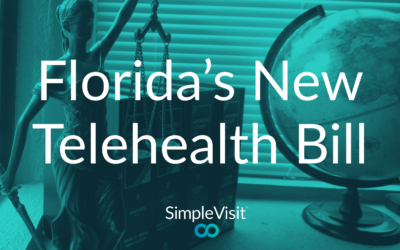
Navigating the Buzzwords of Telehealth
It’s easy to get lost in the ever evolving landscape of the telehealth marketplace. With a host of vendors offering a variety of new products and services, it can be overwhelming for providers just getting started in telehealth. Technical jargon is often the culprit for slow adoption of telehealth among mid-size practices. Understanding these telehealth buzzwords is critical to help differentiate one telehealth platform from another. So without further ado, here is a breakdown of some of the terms most commonly used in the emerging telehealth marketplace.

Tele-
The terms telestroke, telepsych, telemedicine, tele-pediatrics and everything in between often add to the confusion of virtual visits. We often hear from interested clients “I don’t think we need telemedicine in primary care we, already have tele-stroke here.” To which I reply “different specialties have different needs.” It is rare to find a solution with the capabilities to handle emergency care as well as provide a patient facing solution for acute care. Know your practice’s needs, and choose the “tele-” solution that fits for you. Whether a vendor calls their service telehealth, telemedicine, or even virtual care is largely inconsequential; what truly matters is how the product will fit your needs. Telemedicine and telehealth are large encompassing categories of care delivery that should be broken down to fill the unique needs of your providers and patients.
HIPAA Compliant
It is important to note that all video solutions may not be HIPAA compliant. In order for a video solution to meet this standard they must ensure an encrypted end to end solution. The need for a business associate’s agreement depends on how patient protected information and recording options are handled. Make sure you are working with a secure video connection that does not put your practice in jeopardy should be a priority for practices. For more information on this matter check out https://simplevisit.com/is-facetime-hipaa-compliant.
Interoperability
Interoperability is the ability for software to “play nice” from one device to another. When purchasing a telemedicine solution that is going to be accessed by patients, it is important to remember the broad ranges of devices and platforms currently on the market. Being able to work across a variety of platforms and operating systems is a key to making a solution truly interoperable. A question to ask a product that claims to be interoperable might be: does this work on mobile, or would web browsers need a plugin to run – meaning the patient must install something? In a world of PCs, smart phones, tablets, and even smartwatches, it is important to understand what you and your patients will need when accessing your new telemedicine solution.
Integration
One of the hottest topics in healthcare right now is offering integrated solutions. This involves keeping all services and applications under one roof so that information and workflow become less scattered. Some key points of integration for telemedicine are scheduling, recording information into EMRs, and payment. Understanding how telemedicine solutions would integrate or work with solutions you are already utilizing as a provider is extremely important, as poor integration will lead to lost time and a restructured workflow that might not be possible.
Low Bandwidth Functionality
Often you will see a solution flaunt its ability to work in even the most rural of environments. Having a video visit that is optimized for even the worst of conditions is known as having low bandwidth functionality. Live video requires a lot of bandwidth to run, meaning that slower connections don’t often have the capability to run it as smoothly. A provider should consider that their patients may not always be located in areas with particularly good network coverage and be careful to choose a solution that accounts for this. Some video solutions naturally adapt to low bandwidth by cutting video and allowing audio to continue until they can reestablish a video connection to avoid calls being dropped. Others will allow for large lag spikes where the video and audio connection completely freeze. I personally recommended testing in a less than perfect environment if possible, so that you can understand what happens when the connection is less than optimal.
Reimbursable
Reimbursement is leading the charge for telehealth adoption as providers are becoming more financially inclined to offer video visits. However, not all virtual services are reimbursed in the same way, especially according to the state you practice in. For example, in some states known as “parity states” it is at the discretion of the provider to offer virtual services equivalent to those they would provide in person for reimbursement by private insurance. When it comes to technology, a synchronous video connection will often be required over a “store and forward” method (where the patient can view a recording at a later time and then treat). Some states and insurance carriers may have additional restrictions to reimbursement, like the requirement of a previous visit that occurred in person or that the patient is located in an under-served location. Reimbursement can be a confusing area to navigate, but a good telehealth vendor will know the state laws and be able to explain how they will help to foster reimbursable visits for providers.

Navigating the vast world of telehealth solutions can be stressful and overwhelming at times. With the help of this article I hope that you can find solace in knowing the basics of what may differentiate one solution from another, and avoid getting tripped up on the buzzwords of telehealth.
About SimpleVisit
SimpleVisit is a video service which allows patients and providers to connect over the video platform of their choice. With SimpleVisit providers are able to deliver on-demand visits to patients over any device or platform they have available to them. For more information on SimpleVisit and on how we are enabling providers to host virtual visits check out www.SimpleVisit.com
PSYPACT – Live and Rapidly Expanding
Allie Clark | July 5, 2019 | Telemedicine News, LicensingTelehealth is a fulfillment of the dream: “healthcare for everyone, everywhere, anytime.” As telehealth becomes more mainstream and providers begin to see it as a tool rather than a patch; as technology...
Guide to Pricing Video Visits
Allie Clark | 5 min read | May 31Confusion over reimbursement policies for telemedicine appointments contributes to slow adoption among healthcare providers around the county. The emergence of telehealth technology has created a cloud of uncertainty on the economy of...
Florida’s New Telehealth Bill
Allie Clark | 1 min read | May 16April 29, 2019 saw the passing of a new (and long-awaited) telehealth bill by the Florida legislature, and, for the most part, the take-aways are positive. Here are the highlights: Taking effect July 1, 2019: A definition which...



